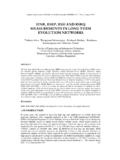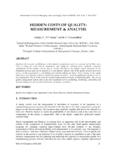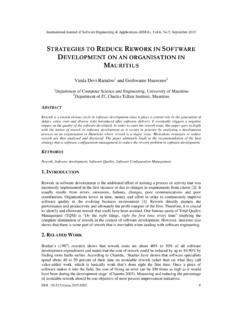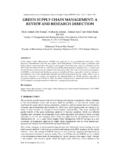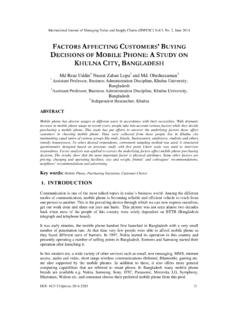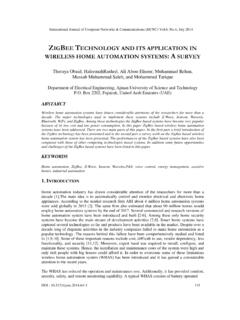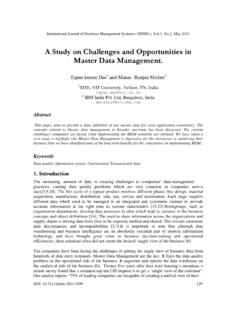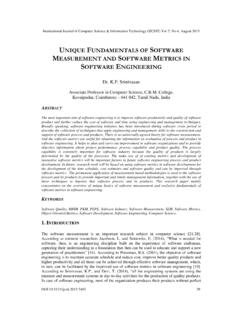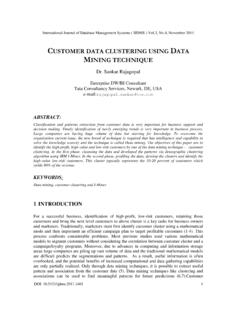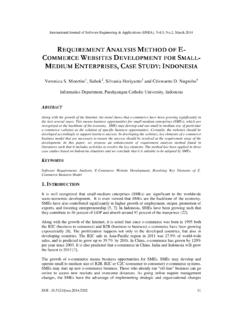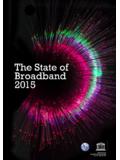Transcription of THE FUTURE DIRECTIONS IN EVOLVING WI-FI …
1 International Journal of Next-Generation Networks (IJNGN) , , September 2014 DOI : 13 THE FUTURE DIRECTIONS IN EVOLVING WI-FI : TECHNOLOGIES, APPLICATIONS AND SERVICES Sumant Ku Mohapatra, Ramya Ranjan Choudhury, Pravanjan Das Department of Electronics & Telecommunication Engineering, Trident Academy of Technology, Bhubaneswar, Odisha, India ABSTRACT New research DIRECTIONS will lead to fundamental changes in the design of FUTURE WiFi networks. However, with an explosion of wireless mobile applications and services, there are still some challenges on the spectrum crisis and high energy consumption.
2 Wireless system designers have been facing the continuously increasing demand for high data rates and spectrum sharing required by new wireless applications and therefore have started research on FUTURE WiFi wireless technologies that are expected to be deployed beyond 2020. In this article we propose WiFi key technologies and there prospective: WiFi CERTIFIEDTM ac and Wi Fi CERTIFIED passpointTM . Also represent super WiFi such as WiGig solution, White Fi, HetNets and Cognitive Fi. FUTURE applications and services facing these potential technologies are also discussed. KEYWORDS WiFi, Super WiFi, HetNets, IEEE standards, Cognitive WiFi,WiGig 1.
3 INTRODUCTION WiFi is surrounding us. What technologies will define FUTURE WiFi ? Will key technologies related to WiFi creates road map towards its FUTURE or emerging super WiFi technologies extends? This paper focuses on new development alternatives that creates wireless access solutions means FUTURE of WiFi. WI-FI KEY TECHNOLOGIES AND PROSPECTIVES. Tri-band WiFi The utilization of tri-band WiFi gets new wireless solutions. By this network topology the data rate increased to 5 Gbps. The aim of this solution is utilized in enterprise to get increased wireless speed, improved wireless access and increased network capacity by using the or WiGig standard. Recent LiFi over WiFi The new technology Light Fi (LiFi) is LED switching on/of technique which transfers data at high speed.
4 The speed of the on and of switching of the LED is converted in terms of data rates. The speed is 1 Gbits/sec. which is 10 times faster than WiFi. International Journal of Next-Generation Networks (IJNGN) , , September 2014 14 Advanced Enterprise WiFi The new wireless technologies for enterprise environments in 2014 will change the trends of enterprise employees. The different ways will advance in coming years such as: Adoption of which represents the upcoming change in the IEEE protocol and increases the data speed into the Gigabit world. Expansion of cloud for small and medium sized enterprises. WiFi- based location analytics will help for different organization to improve the customers and user WiFi experience, to increase business intelligence and to improving the security policy.
5 BY using advance Hot Spot and pass point open services. To allow user to log in to the WiFi network by using their social credentials. WiFi CERTIFIEDTM AC The WiFi CERTIFIED can deliver data rate which is more than double of a network. It supports only the 5 GHz frequency, means signal has less range. It supports multiple antennas that is MIMO(multiple input multiple output). The important feature is beam forming that gets around the general 5 GHz range problem. It States with the signal is propagate for broadcast directly from the access point(AP) to a certain device and back towards the AP. Conventional Wifi Technology FUTURE Beam-forming Technology Figure Beam-forming technique compared with past conventional WI-FI This FUTURE technique shown in Figure 1 as compared to conventional certified equipments meets the security requirement of essential corporate networks and applications and allows residential users to protect their networks [7].
6 Wi- FI CERTIFIED PasspointTM Wi- Fi Certified PasspointTM has given the layout for foundation for latest type of WI-FI experience in public locations. Online sign-up for mobile devices without SIM card is the current passport release for this policy Fi Certified PasspointTM ac builds up the collaboration of the passport, thereby attaining higher capacity of network and improving performance for International Journal of Next-Generation Networks (IJNGN) , , September 2014 15 multi-media content. The new streams of value addition for existing services of end-users is achieved through inter carrier WiFi roaming [2]. FUTURE WiFi speeds From global research [1] , in 2017 ( ) the WiFi connection speeds generated from dual mode devices will increase 3 times to speeds in 2012( ).
7 The Table-1 shows the projected WiFi network connection speeds in Kbps by Global region and different countries. The Figure-2 and 3 illustrates the highest growth in WiFi speeds from 2012 to 2017 with a CAGR (Compound Annual Growth Rate) in Percentage and expected WI-FI Network Connection Speeds by Global Regions from 2014- 2017 respectively[4]. Table-1 - WI-FI Network Connection Speeds by Global Regions from 2012- 2017 (in Mbps) Region/Year 2012 2013 2014 2015 2016 2017 CAGR North America 11 14 16 18 21 23 15% Latin America 5 6 7 8 9 11 18% Western Europe 9 11 12 14 17 18 14% Central & Eastern Europe 10 12 15 17 20 23 19% Middle East & Africa 3 3 3 4 4 4 8% Asia Pacific 6 8 10 13 16 19 26% Global 8 10 12 14 17 20 21% Courtesy:- Cisco VNI 2013 Report International WiFi Roaming WiFi roaming is a vital business related advantages for operators.
8 Now users expect WiFi to be available wherever and whenever they travel. Till now a revenue opportunity has not been successfully captured by operators. A. Super WI-FI : The Real FUTURE To achieve todays spectrum demand different wireless access methods are utilized. Now-a-days WiFi has very much congestion and also provided the consumer a economical path to the network. To achieve the goal of affordable access to all consumers super WiFi is used. Super WiFi will be provided over radio spectrum to share among different user and internet service providers [8]. The major advantages of super WI-FI are :- Super WI-FI (400 meters) signals can travel over long distances than WiFi (100 meters).
9 It can travel 4 times the WI-FI as a result more bandwidth, lower network costs and lower power consumption. International Journal of Next-Generation Networks (IJNGN) , , September 2014 16 It can penetrate two or three concrete walls but WI-FI cannot. Greater efficiency due to longer distance coverage, wider range, more bandwidth and lower power consumption. Super WI-FI devices have the ability to switch from one group of channels to another. Advanced and powerful features. Self-explanatory and user friendly interface. We use to define new development alternatives that create wireless access solutions in FUTURE , including: WiFi Gigabit Dolution (IEEE ad standard) White Fi solution (IEEE af standard) WI-FI approach for Machine to Machine (M2M) communication (IEEE ah standard) HetNets solution Cognitive-Fi (CogFi) 2.
10 WI-FI GIGABIT SOLUTION: IEEE STANDARD The next generation beyond is IEEE ad which is known as wireless Gigabit. It has the speed ability upto 7 Gbps to our WI-FI network. It uses 60 GHz frequency band instead of 5 GHz and GHz band. The important drawback of Wi-Gig is the range which is very much shorter than IEEE standard WI-FI . The WiGig products are targeted to launch by the start of 2015. Figure - 4 shows Wi-Gig at 7 Gbps wireless speed and related application areas[7]. Wi-Gig Beam Management The antenna beam management is a key aspect of feature of Wi-Gig. The beam forming is obtained by using a bi-directional training sequence that is appended to each transmission.
